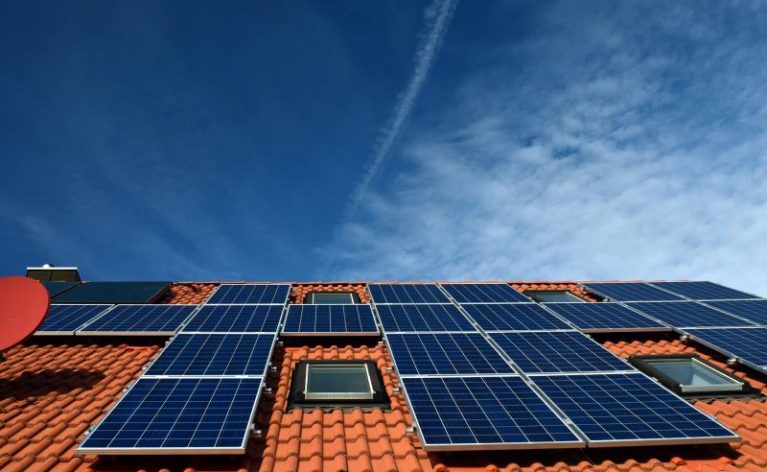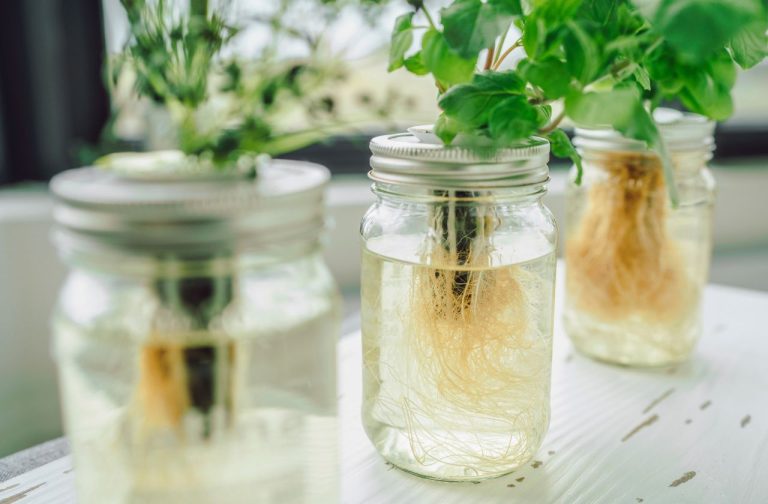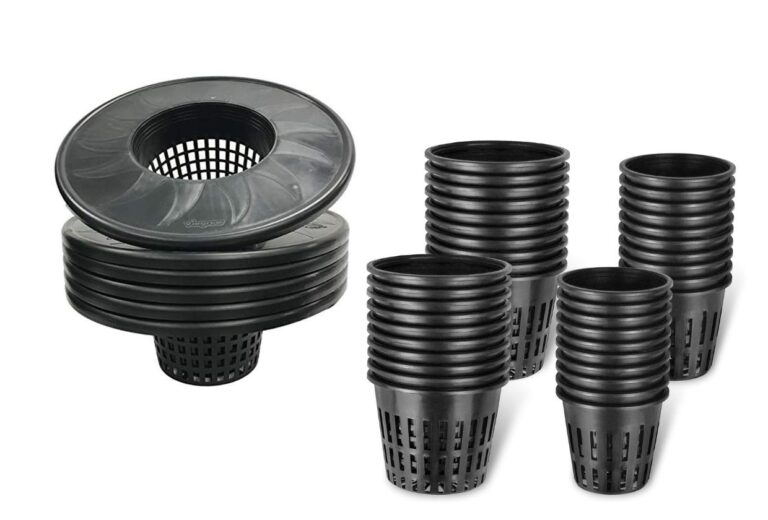Hydroponics Vs Aeroponics
I get commissions for purchases made through links in this post. View our Affiliate Disclaimer.
In the quest for more efficient and sustainable agricultural practices, hydroponics and aeroponics have emerged as two innovative methods for soil-less plant cultivation. Both techniques offer significant advantages over traditional soil-based farming, including increased growth rates, higher yields, and the ability to cultivate crops in areas with poor soil quality.
However, while hydroponics relies on a nutrient-rich water solution to nourish plants, aeroponics takes a different approach by delivering nutrients through a mist or aerosol. We will explore the core principles of hydroponics and aeroponics, comparing their benefits, challenges, and potential applications in the future of agriculture. Whether you’re a seasoned grower or a curious beginner, understanding these alternative cultivation methods can provide valuable insights into evolving your home growing techniques and methods.
Key Takeaways
- Hydroponics delivers nutrients through a water solution, while aeroponics suspends roots in the air, providing 100% oxygen availability.
- Aeroponics uses up to 50% less water than hydroponics, minimizing water waste and promoting plant growth.
- Hydroponics yields up to 20 times more than soil-based growing, while aeroponics yields about three times more.
- Aeroponics demands more attention and upkeep compared to hydroponics, which requires less maintenance.
- Both hydroponics and aeroponics offer precise control over plant nutrition and faster growth, with aeroponics providing greater oxygen exposure and water efficiency.
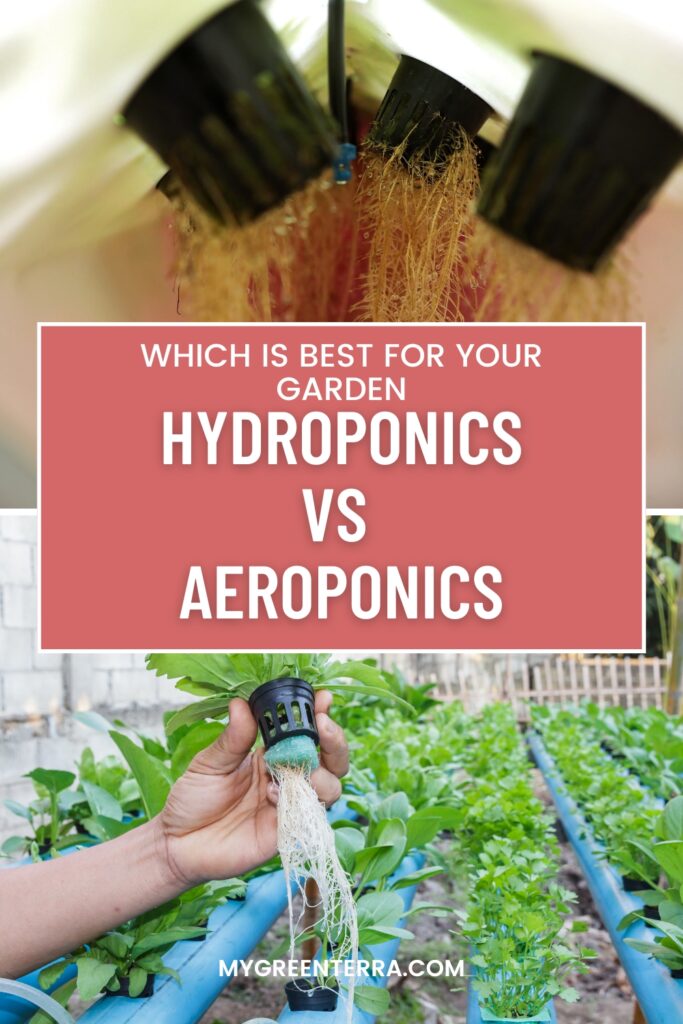
Characteristics of Hydroponics
In hydroponics, you’re growing plants in a nutrient-enriched water solution without soil, where the roots are exposed to a constant supply of nutrients, allowing for a relatively low-maintenance system that supports a wide variety of plants.
This method offers several benefits, including efficient water usage and reduced waste. With hydroponics, you can expect a water efficiency rate of up to 90%, making it an attractive option for water-conscious growers.
The roots are exposed to a consistent supply of nutrients, ensuring ideal nutrient delivery. In hydroponics, growing media like clay, sand, or gravel are used to support the plants, providing a stable environment for growth. This system is relatively reliable, with fewer chances of root rot or nutrient deficiencies.
Characteristics of Aeroponics
When growing plants without soil in aeroponics, the roots hang in the air, constantly misted with a nutrient-rich solution. This unique root environment allows for precise control over nutrient delivery, ensuring your plants receive exactly what they need.
The aeration benefits are undeniable, as roots receive 100% oxygen availability, promoting healthy growth and development. The sterile environment of aeroponics reduces the risk of disease and pathogens, giving you peace of mind.
With resource efficiency in mind, aeroponics uses much less water than traditional farming methods, making it an attractive option for sustainable agriculture. The misting system delivers nutrients directly to the roots, minimizing waste and maximizing absorption.
The benefits of this advanced growing method include increased crop yields, faster growth rates, and improved plant health. By mastering the art of aeroponics, you can boost the full potential of your plants, and reap the rewards of this innovative growing method.
Water Usage
Regarding water usage, aeroponics greatly outperforms hydroponics, using up to 50% less water to achieve the same crop yields. This significant reduction in water usage makes aeroponics a more resource-efficient farming setup, particularly in areas where water conservation is essential.
Aeroponics’ precise nutrient delivery system and controlled root environment contribute to its water-saving benefits. By suspending plant roots in the air and misting them with a nutrient-rich solution, aeroponics minimizes water waste and ensures excellent plant growth.
In contrast, hydroponics submerges roots in a nutrient-rich water solution, which can lead to overwatering and waste. By choosing aeroponics, you can conserve water and promote healthier plant growth and higher yields.
As you weigh the pros and cons of each method, remember that aeroponics water efficiency is a significant advantage, especially for farmers and growers seeking sustainable practices.
Maintenance and Reliability
Maintaining a hydroponic system requires less effort and resources compared to aeroponics, which demands more attention and upkeep to guarantee peak performance. As you consider which method to use, it’s important to think about system efficiency.
Hydroponics tends to be more straightforward, with fewer components to manage. In contrast, aeroponics requires more complex systems to deliver precise amounts of water and nutrients to the roots. This complexity can lead to higher costs in the long run.
Regarding root health, both methods prioritize delivering essential nutrients. However, aeroponics’ misting system can be more effective in preventing root rot and promoting healthy growth.
Concerning cost analysis, hydroponics often has lower upfront costs, but aeroponics can be more cost-effective in the long run due to its water conservation capabilities.
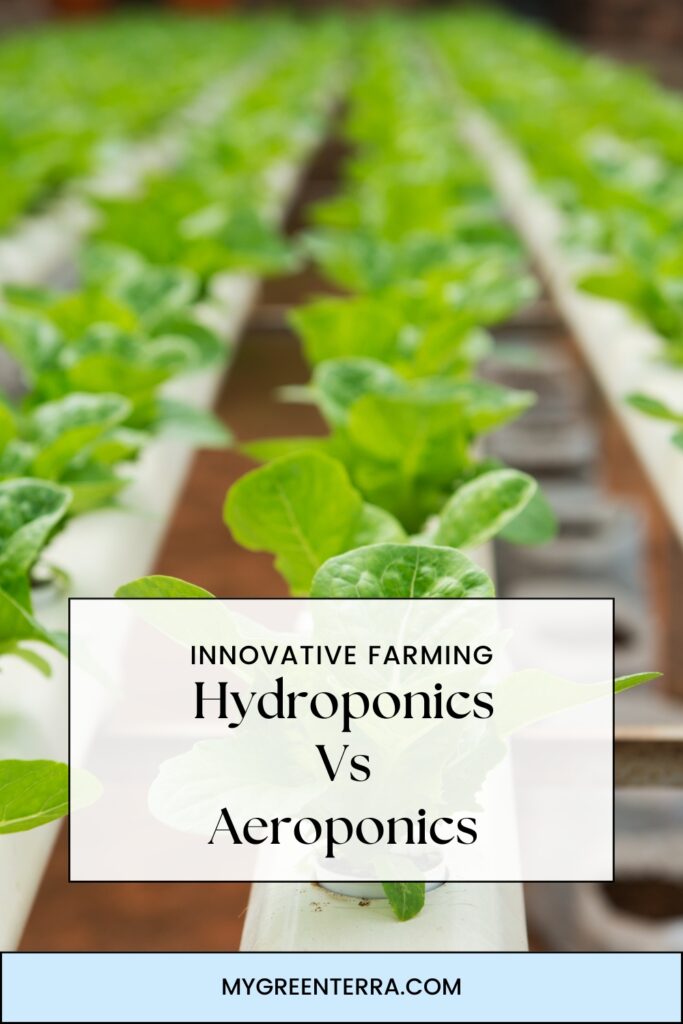
Growing Methods
Your growing methods will determine the success of your harvest, and understanding the differences between hydroponics and aeroponics is essential for making informed decisions.
As you explore these two soilless cultivation methods, consider the following key aspects:
- Growth comparison: Hydroponics yields up to 20 times more than soil-based growing, while aeroponics yields about three times more.
- Nutrient delivery: Hydroponics delivers nutrients through a water-based solution, whereas aeroponics uses a nutrient-rich mist.
- Root environment: Hydroponics uses a solid growing medium or net pots, whereas aeroponics suspends roots in air, providing 100% oxygen availability.
- Resource efficiency: Aeroponics is more water-efficient than hydroponics, using up to 50% less water.
Advantages and Disadvantages
When evaluating the benefits of hydroponics and aeroponics, it’s important to assess their advantages and disadvantages to make an informed decision about which method is best for you.
Hydroponics offers several benefits, including:
- precise nutrient delivery
- a controlled root environment
- resource efficiency
- relatively low maintenance
- supports a variety of plants
However, it requires a larger water supply compared to aeroponics and may be more susceptible to system failures.
Aeroponics, on the other hand, provides:
- even greater oxygen exposure benefits
- faster plant growth
- higher yields
- more water efficiency
- lower risk of bacterial exposure
However, it’s more expensive to set up and requires more maintenance.
When considering the community impact, both methods can provide fresh produce to local communities. From the perspective of growing technology, both hydroponics and aeroponics offer precise control over plant nutrition and environmental conditions, leading to faster growth and higher yields.
Ultimately, the choice between hydroponics and aeroponics depends on your specific needs and resources. By understanding the advantages and disadvantages of each method, you can make an informed decision about which one is best for you.
Applications and Systems
How do you plan to utilize hydroponics and aeroponics in your farming setup, contemplating the variety of applications and systems available? Concerning the applications for hydroponics and aeroponics, the possibilities are endless. From small-scale DIY setups to large commercial farms, these methods can be adapted to suit your needs.
Here are some key applications and systems to explore:
- Vertical farming: Maximize space and increase yields with vertical hydroponic or aeroponic systems.
- Crop variety: Experiment with different crops, from leafy greens to herbs and vegetables, to find the perfect fit for your system.
- Nutrient delivery: Choose from various methods, such as drip irrigation or misting systems, to deliver essential nutrients to your plants.
- Sustainability benefits: Enjoy the environmental benefits of reduced water usage, increased crop yields, and minimal land use.
Environmental Impact
By adopting hydroponics or aeroponics, you can greatly reduce your environmental footprint, minimizing water usage, land consumption, and waste production. These soilless farming methods offer significant sustainability benefits, as they require much less water and land compared to traditional farming practices.
Hydroponics and aeroponics promote resource efficiency, allowing you to grow more food in smaller areas while minimizing waste. Nutrient delivery is also optimized, ensuring plants receive exactly what they need to thrive.
When comparing growth rates, aeroponics tends to yield faster results, with some studies suggesting up to three times more production than traditional farming methods. Hydroponics, on the other hand, can yield up to 20 times more than traditional farming.
Both methods provide a more controlled environment, reducing the risk of pests, diseases, and parasites. By choosing hydroponics or aeroponics, you’re not only reducing your environmental impact but also contributing to a more sustainable food system.
Industry and Technology
Companies like Eden Green Technology are revolutionizing the way we grow and consume produce, offering hydroponic food for retail and providing customers with a wide variety of fresh, customizable, and high-quality produce year-round. As the demand for sustainable and innovative farming practices continues to grow, the industry is witnessing significant advancements in technology and market trends.
Here are 4 key areas where hydroponics and aeroponics are making a significant impact:
1. Industry Impact
Hydroponics and aeroponics are transforming the way we produce and consume food, offering a more sustainable and efficient alternative to traditional farming practices.
2. Technological Advancements
Advances in technology have made it possible to develop more efficient and precise systems for nutrient delivery, climate control, and crop monitoring.
3. Market Trends
The demand for locally grown, organic, and sustainable produce is driving the growth of the hydroponics and aeroponics market, with companies like Eden Green Technology leading the way.
4. Innovation Strategies
Companies are investing in research and development to improve crop yields, reduce water usage, and increase efficiency, paving the way for a more sustainable future in agriculture.
As the industry continues to evolve, we can expect to see further innovation and growth in the field of hydroponics and aeroponics, driving towards a more sustainable and food-secure future.
Additional Must-Have Resources For Successful Homesteading
Get Yours Now!
Frequently Asked Questions
Can I Use Aeroponics for Growing Large-Scale Commercial Crops?
You can definitely use aeroponics for large-scale commercial crops, enjoying increased crop yields, improved farm efficiency, and significant water conservation, all while maintaining scalable systems and ensuring commercial viability.
How Do I Control Ph Levels in Hydroponic Systems?
You’ll master pH control in hydroponic systems by monitoring with pH meters, maintaining nutrient balance, and using acid injection to adjust levels, all while minimizing pH fluctuations and ensuring excellent water quality.
Are Aeroponics and Hydroponics Suitable for Growing Root Vegetables?
You can successfully grow root vegetables using aeroponics or hydroponics, as both methods provide precise control over nutrient uptake, allowing for ideal root depth and soil emulation, resulting in increased veggie yields and a wider crop variety.
Can I Use DIY Hydroponic Systems for Small-Scale Gardening?
“Embrace liberation in small-scale gardening with DIY hydroponic systems! You can conserve water, enjoy year-round harvests, and savor the benefits of indoor systems, all while cultivating a thriving garden, minus the soil, in the comfort of your own space.”
Do Hydroponics and Aeroponics Require Special Licenses or Permits?
You’ll need to navigate local regulations, permit costs, and legal frameworks before setting up your DIY hydroponic system, as government policies and zoning laws vary, so research and comply to avoid any legal hassles.
Conclusion
Now that you’ve explored the key differences between hydroponics and aeroponics, you can decide which method best fits your needs. While hydroponics offers a more established, user-friendly approach, aeroponics provides unparalleled water efficiency and growth rates.
Ultimately, the choice between these innovative growing methods depends on your resources, goals, and priorities. By understanding their unique characteristics, you can harness the full potential of soilless cultivation and contribute to a more sustainable agricultural future.
Get more posts like this
Subscribe to our mailing list and get interesting homesteading and green living info and updates to your email inbox.
Thank you for subscribing.
Something went wrong.




